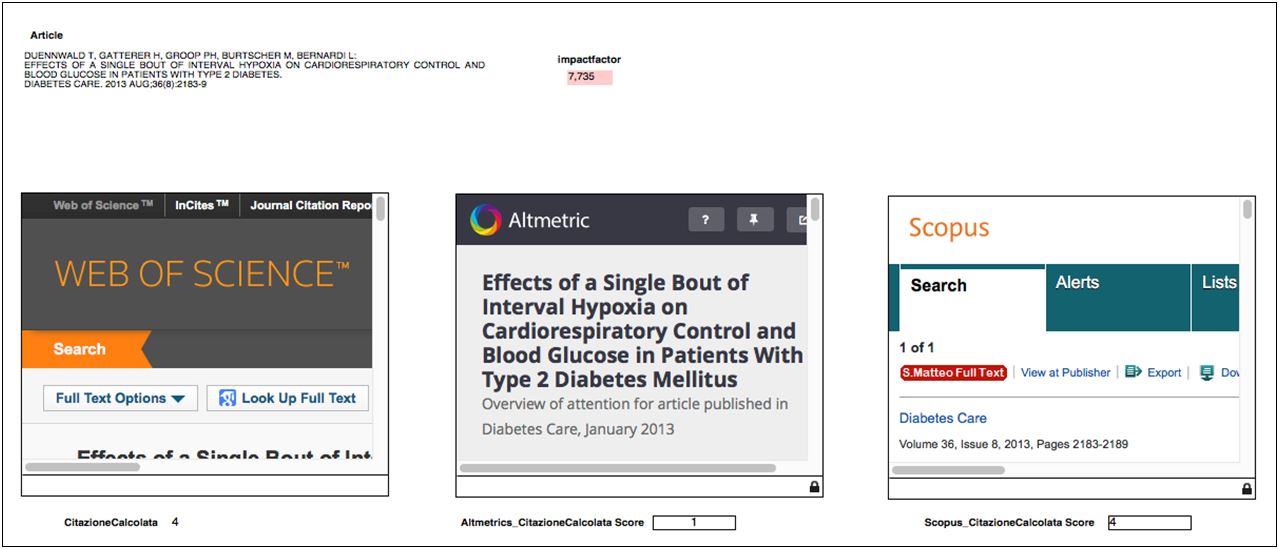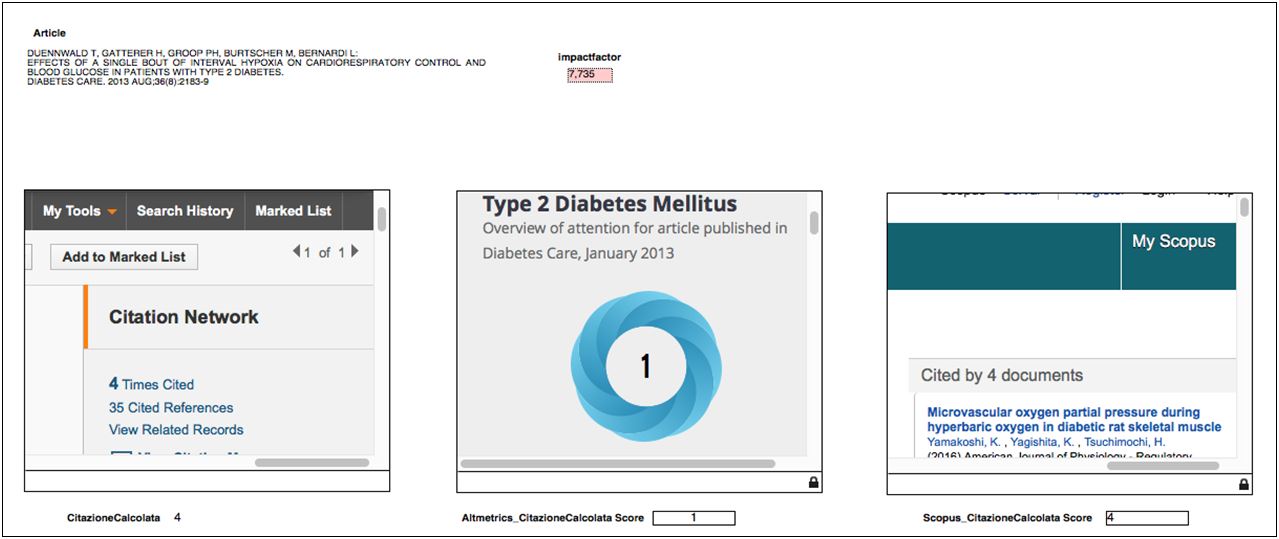Valeria Scotti1, Funda Topuz1, Chiara Rebuffi1, Paola Abele1, Moreno Curti1
1Center for Scientific Documentation, IRCCS Policlinic San Matteo, Pavia, Italy
Corresponding author: Valeria Scotti, v.scotti@smatteo.pv.it
Abstract
Introduction:
Bibliometrics and Altmetrics are increasingly on the agenda in a scientific library. In an era of rationalization of resources, these parameters become a valuable ally in decision taking. The term Altmetrics takes its place alongside well-known terms as H-index or Impact Factor (IF); understanding and learning these new indices opens the way to a progressively web 2.0 oriented library, able to interact with social networks and a wider society.
Objectives:
Each year, all the Scientific Institutes of Medical Research in Italy communicate the complete list of scientific publications in their research areas to a central database at the Ministry of Health (MoH). This is one of the main factors for resource allocation for the annual Current Research activities by the MoH.
Methods:
With FileMaker 11 software, we have created a particular database that allows us to collect both the citations and the Altmetrics for all articles produced by our researchers at the Foundation in one single interface. The database is connected to the data of our scientific production divided by year: the production is broke down by department, and reports the number of publications and its list, together with the total impact factor for each department . The DOI (Digital Object Identifier) and Web of Science Accession Number have been inserted for each article. Launching the update, the system is able to connect to both Web of Science, through the Accession Number, and to Altmetric.com through API (application programming interface) codes based on DOI. The system was tested for the year 2013.
Discussion:
The system provides real-time data in a single interface. This allows us to monitor, the citations on one hand and the Altmetric Score on the other, throughout the year. In addition, the database allows us to extrapolate the data in an Excel file in order to examine the data also for comparison through several years. Furthermore, having the IF of each publication, we have a complete picture of the impact of our scientific output.
Conclusion:
Having a large amount of publication data already collected in a standard database, we plan to extending the analysis to the scientific for the next years.
We plan to measure the broad impact of our researchers in the academic community and on the society in a different way from what has traditionally been done. Moreover, we would like to explore the possibility of combining the Altmetrics to traditional indicators as a possible parameter, alternative or supplementary to them, to assess over a given period of time, the impact of scientific works and corroborate whether this “time” affects their trend. Last but not least we would like to study how and if libraries could use these new indicators in their daily work.
Key words (Times New Roman 12, Italics): Altmetrics, Bibliometrics, Hospital, Journal Impact Factor, Hospital Library, Database
Background
The problem of measuring the scientific and social impact of research publications has been of extreme interest to scientists and scholars since the inception of modern science, but it has always been hard to answer.
Counting citations that a research article received by other articles was the traditional method for the evaluation of a scientific paper. Bibliometrics is the application of quantitative analysis and statistics to publications such as journal articles and their accompanying citation counts.
The Journal impact factor and the H- Index are the most well known indicators based on the citation analysis. In this context, many web tools are often referred as ‘social media’ due to their role in supporting communication and building communities (e-i.: Facebook, Twitter, etc.) (1). Altmetrics is the creation and study of new metrics based on the Social Web for analyzing and informing scholarship. (2). Aims of this new metric is to combine the traditional Bibliometrics tool with the use of the web.
The development of tools even more Web 2.0 oriented has profoundly changed the scientific communication process (3). All of these new sources are alternative indicators of impact which go beyond traditional citation, focusing on the contents and uses of the social web.
Such information is provided in real time and altmetrics show not only the impact of scientific research by researchers, but also the impact of the research to the public through the social media (4).
Aim of the study
Our purposes are firstly to understand these new metrics, acknowledge how they work and assess their validity on research impact.
All IRCCS in Italy, by April each year, communicate to a central database (http://ricerca.cbim.it/index_en.html) the complete list of scientific publications in their research areas for the Italian Ministry of Health (MoH). The scientific impact is, in fact, one of the most relevant criteria for funding and grants. Furthermore, this is one of the main factors for resource allocation for the annual Current Research activities by the MoH. The IF is also used to allocate the obtained funds to the departments within the institution. At our hospital, we also use these data for publication of the “blue booklet” that is distributed to our researchers.
We aim to examine the correlation between IF and altmetrics score obtained in each department of our hospital in order to see if altmetric score could better reflect the impact of research.
Then we aim to compare traditional and altmetrics impact at single researcher level.
Finally, we would point out how these new metrics can work alongside with the traditional ones and become a useful tool for the assessment of the impact of our Foundation’s scientific production.
Methods
With FileMaker 10 software, we have created a particular database that allows us to collect both the citations and the Altmetrics for all articles produced by our researchers at the Foundation in one single interface. The database is connected to the data of our scientific production divided by year: the production is broke down by department, and reports the number of publications and its list, together with the total impact factor for each department . The DOI , theWeb of Science Accession Number and has been inserted for each article. In the last mouth, we have also tested the system with Scopus by entering the Electronic ID (EID) code that identifies each individual article. Launching the update, the system is able to connect to Web of Science, through the Accession Number, to Scopus by EID code and to Altmetric.com through API codes based on DOI (see Figure 1 and Figure 2)
The system was tested for the year 2013.

Figure 1: Article reference, the Impact Factor of the journal and the three database

Figure 2: single article scores
Discussion
The system provides real-time data in a single interface. This allows us to monitor, on the one hand the citations and on the other hand the Altmetric Score, throughout the year. In addition, the database allows us to extrapolate the data in an Excel file in order to examine the data also for comparison through several years. Furthermore, having the IF of each publication, we have a complete picture of the impact of our scientific output.
Conclusion
Altmetrics are user friendly, graphic, self-explaining also for non specialized readers, rapidly evolving and interacting with media and public or users. Furthermore, it could actually represent an interesting and relevant complement to citations, providing institutes and researchers with a new framework to evaluate not only their academic influence but also their social impact. Together with traditional metrics, they could also be a useful tool in guiding decision makers when funding public research.
Having a large amount of publication data already collected in a standard database, we plan to extending the analysis to the scientific for the next years.
We plan to measure the broad impact of our researchers in the academic community and on the society in a different way from what has traditionally been done. Moreover, we would like to explore the possibility of combining the Altmetrics to traditional indicators as a possible parameter, alternative or supplementary to them, to assess over a given period of time, the impact of scientific works and corroborate whether this “time” affects their trend. Last but not least we would like to study how and if libraries could use these new indicators in their daily work.
REFERENCES
- Priem J, Hemminger B. Scientometrics 2.0: New metrics of scholarly impact on the social Web. First Monday. 2010;15(7).
- Torres-Salinas D, Cabezas-Clavijo Á, Jiménez-Contreras E. Altmetrics: nuevos indicadores para la comunicación científica en la Web 2.0. Comunicar: Media Education Research Journal. 2013;21(41):53-60.
- Adie E, Roe W. Altmetric: enriching scholarly content with article-level discussion and metrics. Learned Publishing. 2013;26(1):11-17.
- Haustein S, Peters I, Sugimoto C, Thelwall M, Larivière V. Tweeting biomedicine: An analysis of tweets and citations in the biomedical literature. Journal of the Association for Information Science and Technology. 2013;65(4):656-669.

